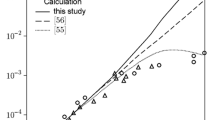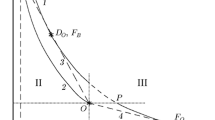Abstract
A mathematical model is proposed to describe ignition and combustion of a hydrocarbon fuel (kerosene vapor in air). Based on an analysis of experimental data on the ignition delay dependence on temperature, approximation formulas are derived for the ignition delay as a function of species concentrations and of the pressure and temperature of the mixture. A method for determining the pre-exponent in the kerosene combustion kinetic equation as a function of the local temperature of the mixture is proposed, which provides a reasonably accurate description of the time of mixture combustion. Based on this kinetics, the structure of the detonation wave in a stoichiometric kerosene-air mixture and in a mixture with a reduced fraction of the oxidizer for the Chapman-Jouguet and overdriven detonation regimes is described.
Similar content being viewed by others
References
D. F. Davidson, D. C. Horning, J. T. Herbon, and R. K. Hanson, “Shock Tube Measurements of JP-10 Ignition,” Proc. Combust. Inst. 28, 1687–1692 (2000).
S. Wang, H.-J. Gou, B.-C. Fan, et al., “Shock Tube Study of JP-10 Ignition Delay Time,” Chinese J. Chem. Phys. 20(1), 48–52 (2007).
S. Wang, B. C. Fan, Y. Z. He, and J. P. Cui, “Shock Tube Study of Kerosene Ignition Delay,” Chinese J. Chem. Phys., No. 18, 775–780 (2005).
A. V. Pinaev and A. I. Sychev, “Ignition of Fuel Droplets Behind a Shock Wave Front,” Fiz. Goreniya Vzryva 18(6), 81–90 (1982) [Combust., Expl., ShockWaves 18(6), 682–689 (1982)].
J. M. Austin and J. E. Shepherd, “Detonations in Hydrocarbon Fuel Blends,” Combust. Flame 132(1, 2), 73–90 (2003).
B. Franzelli, E. Riber, M. Sanjos, and T. Poinsot, “A Two-Step Chemical Scheme for Kerosene-Air Premixed Flames,” Combust. Flame 157, 1364–1373 (2003).
P. Dagaut and M. Cathonnet, “The Ignition, Oxidation, and Combustion of Kerosene: A Review of Experimental and Kinetic Modeling,” Progress Energ. Combust. Sci., No. 32, 48–92 (2006).
S. Vasu, D. Davidson, and R. Hanson, “Jet Fuel Ignition Delay Times: Shock Tube Experiments over Wide Conditions and Surrogate Model Predictions,” Combust. Flame 152, 125–143 (2008).
A. Dean, O. Penyazkov, K. Sevruk, and B. Varatharajan, “Autoignition of Surrogate Fuels at Elevated Temperatures and Pressures,” Proc. Combust. Inst. 31, 2481–2488 (2007).
Author information
Authors and Affiliations
Corresponding author
Additional information
Original Russian Text © A.V. Fedorov, D.A. Tropin.
__________
Translated from Fizika Goreniya i Vzryva, Vol. 48, No. 1, pp. 47–54, January–February, 2012.
Rights and permissions
About this article
Cite this article
Fedorov, A.V., Tropin, D.A. Mathematical model of detonation combustion of kerosene vapor in an oxidizer. Combust Explos Shock Waves 48, 41–48 (2012). https://doi.org/10.1134/S0010508212010066
Received:
Published:
Issue Date:
DOI: https://doi.org/10.1134/S0010508212010066




